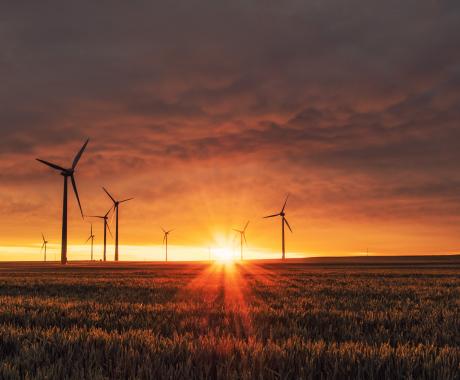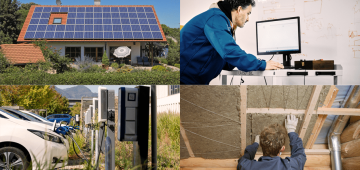Jul 2021
A Guide to the Energy Transition
The energy (or environmental) transition is a general term that may or may not be concrete at this point. And yet, this transition has already begun and will obviously continue since climate change is more and more acute and tangible.

The energy (or environmental) transition is a general term that may or may not be concrete at this point. And yet, this transition has already begun and will obviously continue since climate change is more and more acute and tangible.
But what can companies and public or private organisations do to contribute to this transition? What are their obligations?
Defining the energy transition
Defining the energy transition is relatively simple. It means moving away from fossil fuels, dwindling resources, and instead increasing the use of renewable energies which, as a rule, won’t run out of stock.
Energy from the wind, through windmills, and from the sun, through solar panels, are part of the solution. But the energy transition doesn’t stop there: the goal is to affect global change by limiting energy consumption and the greenhouse effect. One of the transition’s pillars is therefore energy efficiency.
The energy transition as enshrined in law
In France, the energy transition is enshrined in the eponymous law of August 17, 2015 “relative to the energy transition for green growth”. The aim of this law is also to strengthen France’s independence relative to its energy needs.
The loi énergie climat (energy and climate law) is even more ambitious and is currently being debated in parliament. Its aim is to reduce fossil fuel consumption by 2030. It also aims to achieve “carbon neutrality” by 2050: that is to produce fewer greenhouse gases than what the French soil can absorb.
In the law, there is a plan to shut down 14 nuclear reactors by 2035 and to close the last coal-fired power stations by 2022, which might as well be tomorrow.
What steps are companies taking towards the energy transition?
Companies have many levers at their disposal in terms of norms and tools. They also have some obligations depending on their size and their annual turnover. But all companies and public bodies can engage in an environmentally friendly approach to limit their energy consumption and to decrease greenhouse gas emissions.
An energy audit can be conducted to know how much energy the company precisely consumes. It also pinpoints energy-intensive areas, waste and overconsumption in general. The energy audit is in fact mandatory for large companies. Smaller organisations can nevertheless get on board with more appropriate solutions, such as a fully digital and remote audit to establish the foundations of the company’s energy transition.
The company's CSR policy (which is compulsory for a number of companies) is also a tool encouraging the energy transition. The aim of the policy is indeed to lower one’s imprint, both on the environment and on society. Therefore, reducing the company’s consumption and greenhouse gas emissions becomes a priority.
Other steps, not generally compulsory, can also lay the groundwork for concrete energy savings. This is the case of the ISO 50001 standard which certifies that a company has taken the necessary steps and that its consumption has truly gone down. Since organisations adapt the standard based on their reality, they aren’t required to achieve specific numerical results. But the standard’s framework allows them to set up the right measures to move forward.
l Which subsidies can companies receive when they engage in the energy transition?
- The ADEME (French Environment and Energy Management Agency) is the first point of contact for companies when they are looking to finance their energy transition. Companies must contact the ADEME directly and present their project. They can also answer a variety of calls for projects, the latter of which are often managed locally.
- Other types of subsidies exist for large companies and smaller businesses. One of them is the energy savings certificate (certificat d'économie d'énergie - CEE) where companies pair with energy providers to fund an energy transition project. But, as specified by the ADEME agency, CEEs cannot be combined with other forms of aid.
- Medium to small businesses can benefit from a loan from BPI France which can be combined with CEEs. In order to benefit from this, the company must have at least 3 years of existence and its financial situation must be sound.
Which quick actions can be set up to start a transition process?
While the energy transition is a broad concept, it affects all of us and, to an even greater extent, companies and public and private organisations.
Extravagant budgets and pharaonic projects aren’t needed to start this essential – if not mandatory – process.

In certain circumstances, and when initiating the transition process, decreasing the company’s energy consumption is the easiest way to start. By doing this, the company gains a better understanding of the issues and starts finding alternatives. After an audit, even a remote one, energy performance tools can be installed. They can take the shape of connected objects (Internet of Things) to measure your consumption and alert you. Online dashboards are also included; they clearly detail your consumption and suggest ways to save energy.
An energy manager can support you from the beginning. An external company can be hired for this if you aren’t able to assign this position to someone in particular. It offers the services of a member of staff dedicated to energy management, someone who’s there to help you from the start of the process and throughout your energy transition.
The energy transition is a France-wide – and worldwide – challenge. Since everything starts with specific actions aimed at lowering consumption and greenhouse gases, your role and that of your company are very important. Simple and efficient tools are a great way to start and will provide you with a quick return on investment!
Picture by Jarrett Tan on Unsplash
Last news



